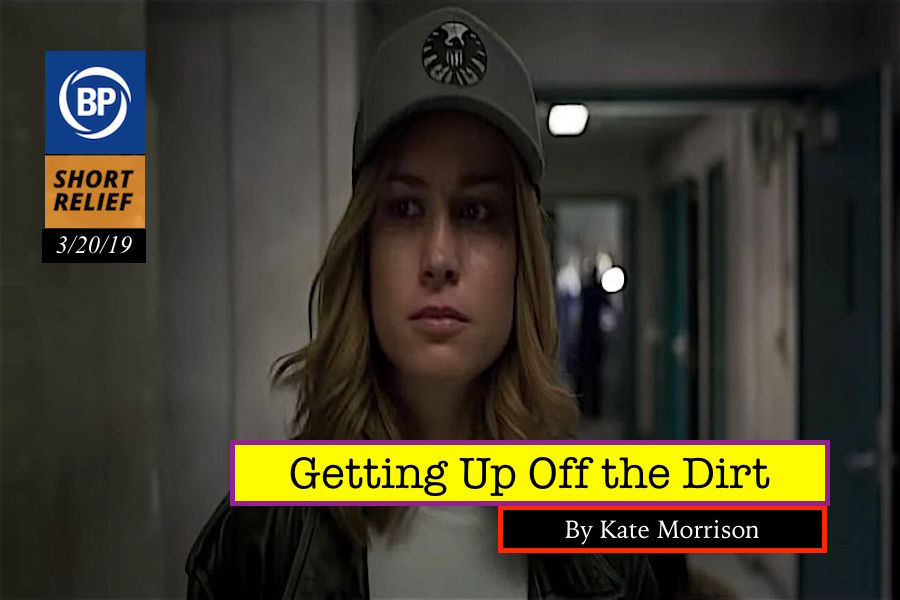
(Editor’s Note: Light spoilers for Captain Marvel.)
Captain Marvel played baseball.
Baseball, the ur-American sport, the sport above all others that has been held out as what women can’t do[1], a sport that even today struggles with the idea that women can and want and should be considered shoulder to shoulder with the men in uniform we’ve always seen – this is the sport that the Marvel screenwriters decided to show. Carol Danvers would play baseball, and not just baseball, but baseball in either the late 1970s or early 1980s – at the very most, five or six years after the rule change that allowed girls to play in Little League.
Today, 45 years later, it’s still unusual to see a girl in Little League baseball. Carol Danvers gets her head thrown at circa 1979. In 2018, coaches in a New Hampshire youth baseball league planned to have their players throw at the head of the only girl in the league until she quit. The stories repeat themselves over and over. Danvers may be fictional, but that the atmosphere is the same – that the Marvel screenwriters could rip something from a Deadspin headline in 2018 and make it work in 1979 – just shows how much further we have to go.
But how perfect is it that Carol Danvers plays baseball? She picks herself up out of the dirt and digs back in, unafraid of the boys and the men (and later, the mentor-figures) who want her to restrain herself for their sakes. It’s such a short moment, too, a part of a larger montage that shows her being stubborn and willful and gloriously unafraid, and yet it says so much. Of course Carol Danvers wouldn’t play basketball, run track, or figure skate[2] – all popular sports in the 1980s that often require the courage to get back up. No, she’d do the thing she was told she couldn’t: The thing so many girls were told they couldn’t, even after the 1974 lawsuit and rules change. She’d play baseball. It only makes sense.
Of course, just because it was unusual doesn’t mean that this choice would make her unique, were she to exist. In 1979, Crystal Fields beat the boys in the national Pitch, Hit, and Run competition, at that time a part of preliminary events to the All-Star Game, becoming the first girl to do so. In 1984, Victoria Roche of Belgium became the first girl to play in the Little League World Series. Yet, it’s still a news story, 35 years later, when we’re reminded that girls, too, play baseball. When it’s shown again that girls have always played baseball. Girls invented baseball’s ancestor, when milkmaids in England played a game involving stools as bases and throwing rocks at the stools or the runners to retire them.
Making Captain Marvel part of that history only feels right for the story the movie told, about a woman fighting past expectations and barriers and boundaries. It’s a love letter to the baseball player in New Hampshire, the girls of the Trailblazer Series, the women who play professional baseball, and any girl who has ever defied expectations.
[1] We can talk about football, but there isn’t a “similar but unequal” secondary sport for women who want to play football.
[2] Though, amusingly, US Figure Skating’s current slogan is “We Get Up,” which is certainly appropriate.

When you were a kid, you thought you’d be an astronaut. You could think of nothing else. You borrowed all of those books from the library, memorized the constellations, begged for a telescope for Christmas, and then for your birthday, and then for the Christmas after that, at which point you finally gave up. As you got a little older, the pieces of the plan started falling into place in your head. You would get this degree, and this degree, and that would take you straight to NASA. And from there — the stars. Different planets, different worlds. Things never seen.
But your astronaut fantasy never got as far as you actually being in space. You were always earthbound, trapped within the scope of what you knew. You never saw yourself in the stars. You could only imagine yourself as you were, small and distant, looking up from far away.
***
When you wake up in the afternoons now, you see the blank ceiling of your childhood bedroom. You were never smart enough to become an astronaut. You got your useless degree, you got the student debt you’ll never pay off, and now you’re back at home. You lie in bed for hours before you get up. This is your life: the sounds of the boiler room chugging beneath you, the slow drip of a never-fixed faucet.
Sometimes, in the evening before she goes to bed, your mom knocks on the door and tells you that the stars are out, or that there’s some kind of special moon, or that it’s just a beautiful night. She always sounds kind of hopeful. You hate that. When she leaves, you keep the blinds closed.
***
Your friend convinces you to go for a walk one night. He’s waiting for you at the park where you used to drink in high school, the baseball diamond with its dugouts full of empty beer cans. You never played any sports, because you knew you would be bad at them. But you sat in that dugout a lot.
You walk without seeing anything. Everything is so familiar that the environment is just assumed, filling itself in around you. You blink, and you’re already almost there. You can see the figure of your friend, standing in the field. You hop the fence onto the grass.
Something hits you hard on the arm, and suddenly, everything is sharp.
“Ow, what the fuck?” you yell.
Your friend, far away, is laughing. On the ground beside you lies the projectile that hit you. You pick it up. It’s a dirty old baseball. The seams are fraying, and the leather is peeling. You take a deep breath. With all the force you can muster, you hurl the ball back at him. It sails high in the air.
And you can see it flying. And you can see the stars around it, and the darkness behind them, and the invisible lines connecting it all that you’ve never managed to forget. There’s Orion. There’s the North Star. They’re billions of years old, and they sparkle like they’re new.
The ball lands in your friend’s hands. “Not bad!” he calls. “I didn’t think you had it in you.”
You take a deep breath in again. You feel the pain shooting where you got hit, and the dirt from the ball in your fingernails. You look up at the sky, on purpose this time, and when you blink, the stars are still there.
“Hit me,” you yell.
When he throws the ball back to you, you catch it.
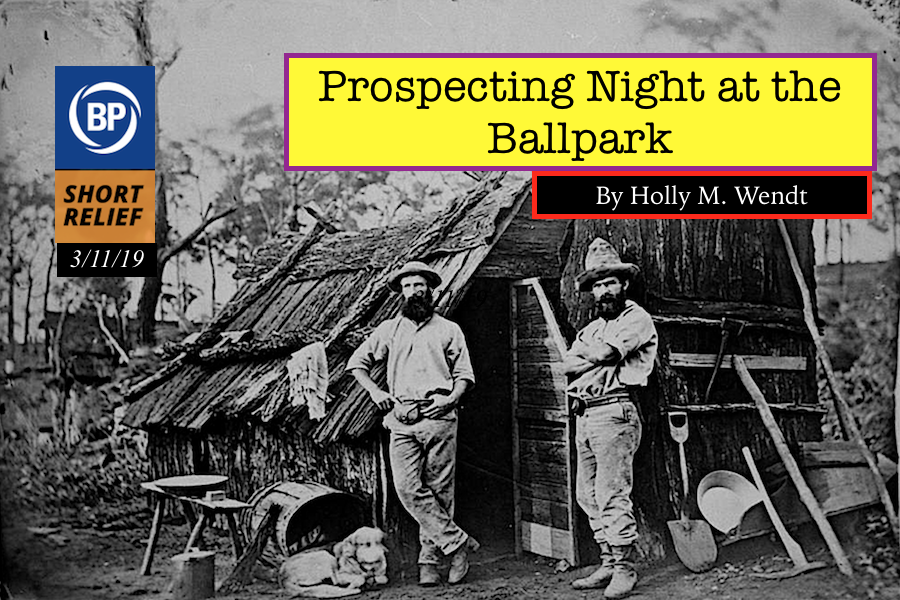
It’s a new way to spend a rain delay or a wily ploy to sell more beer, but ballparks all over the nation are launching their Prospecting Night at the Ballpark initiatives. You read that right—not prospect night, but prospecting night.
It all began at a Las Vegas Aviators game. Eleven-year-old Brayden Jones, disoriented from a Dizzy Bat Race, sprawled in dirt near the home team’s dugout and rose with a 2.2 gram lump of gold in his hand. Jones, having just learned about the gold rushes in the American West in his social studies class, was elated.
“I did one of those little panning things at Disneyland and found some pyrite, but everyone finds pyrite. It’s part of the schtick. But this is real!” Jones was invited to take part in the official launch of Prospecting Night. “It was really weird to stick a shovel in the infield,” he said. “I hope the players don’t get mad.”
“I think someone just lost a filling,” said a grounds crew member who wishes to remain anonymous. “And now it’s way out of control. I mean, all the dirt in the infield gets brought in from outside. If you want to dig in it, go out there. My back is already bad.”
Other members of grounds crews across the minor leagues have expressed similar exasperation, but team executives are excited about the possibilities, as they’ve been able to increase revenues via prospecting tickets and the “halfsies on whatever you find” conditions on these special promotional experiences. “We’re confident someone’s going to strike it rich,” ownership group member Fairfield Dixon said. “It’s incredibly special to be able to take part in these kinds of extraordinary fan experiences. I haven’t, myself, been to the park yet, but my dad would be thrilled to see this kind of agile use of the ballpark. Loved the game, my old dad did. He’d be just ecstatic. With the new pace of play changes, we might make up enough time for a seventh-inning dig.”
Fontaine Lagares, of Arrolime, Nevada, is less convinced. “‘Extraordinary experiences?’ You mean bilking fans the way you do these players themselves. Just let us see the boys play. I can watch my kids dig in the sand any time.” Lagares has twice housed players during short season baseball and is a vocal critic of service time manipulation. She also has no fewer than six velour bags stuffed with stones and pressed pennies from theme park “pan for gold” attractions, thanks to her two children. “They call it fool’s gold for a [expletive] reason.”
Others, however, are more optimistic. “I found something,” utility infielder Logan Parks said. “I went out to take a few more grounders last week, and someone had left one of those little pans out. I had some water with me, so I figured, might as well. And it panned out.” Parks laughed.
“I told you I lost an earring,” teammate Darren Esquivel said. “Just show me. It’s the one my nana bought me when I was drafted.”
But Parks, like any good prospector, isn’t sharing his secrets.
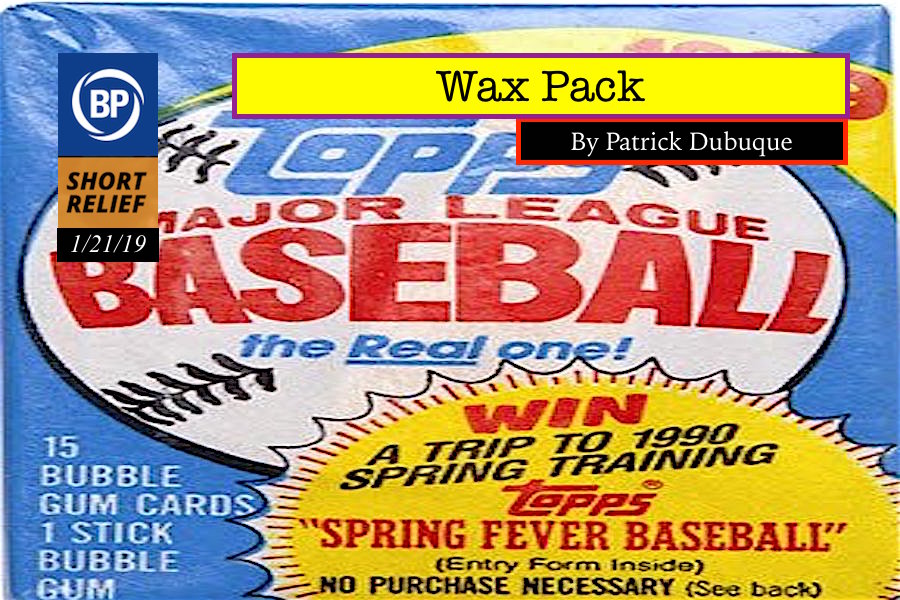
When I was ten years old, during the decade when all the kids collected baseball cards for three months, I had an idea.
I had a couple of friends who lived up the hill from me. One lived in a giant house, the son of a doctor and a lawyer; I spent countless days losing to him in the pickleball court in his backyard, and playing computer games like King’s Quest in his basement. He used to arrange his cards on the walls of his room, tacking up plastic pages and putting the best cards in them; he had a Jordan rookie that his parents made him keep safe, but we marveled at Mark McGwire in his Olympic gear and Jose Canseco with his wispy mustache.
I rarely stayed over at the other friend’s place, even though I liked him just as well. He lived in a small apartment with his mom but not his dad, and we often met in the municipal park nearby and played catch and football. He was a better person than I was, in a way that even a ten-year-old could tell; we were all good kids, but he was Good. His card collection was a loose pile in a box near his bed, and I made a few bad trades with him to make him feel like his collection had cards worth trading for. One was an Alex Cole rookie card that I told him was worth a dollar. I’ll always remember Alex Cole for that.
My collection, and my house, were in between those two. I didn’t really consider the difference between them; we were just friends. It was the latter friend’s birthday soon, and though we were ten-year-olds and were in the habit of receiving gifts rather than giving them, I bought a pack of 1989 Topps baseball cards, in its cheap, waxy blue wrapper. I went home, opened the pack, and looked through it.
And then I made the best pack ever created. Topps didn’t make a Griffey rookie that year, but I loaded in all the best names: a Gregg Jefferies, of course, and a Canseco and a McGwire and a Mike Greenwell and a Kevin Mitchell and a Gregg Olson. Then I carefully rubbed a glue stick over the back of the wax wrapper, and folded them all in again. The next day, I gave my friend a pack of baseball cards for his birthday.
I watched him as he peeled open the wrapper and flicked through each card with the familiar motion of thumb and forefinger. He grew incredulous as each name passed him by. He was so happy. For once he was the luckiest kid in the world, as long as I didn’t tell him what I had done, that I had duplicates of every card he’d prized, that he wasn’t really lucky after all.
But I was ten years old, and I was only a good kid. I told him. I told him.
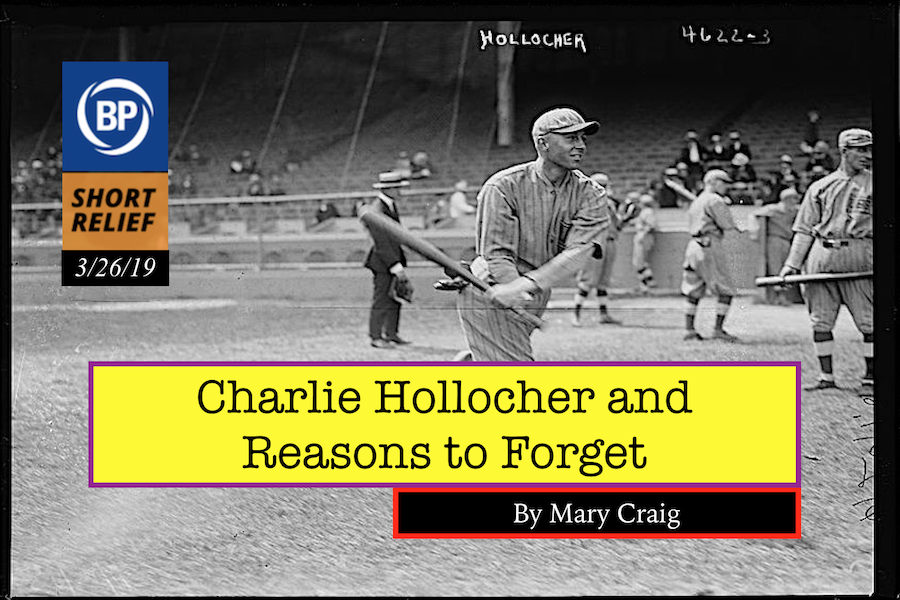
Throughout its lengthy history, professional baseball has deemed many players to be the “forgotten man,” most left behind because they weren’t skilled enough or weren’t around for long enough. However, a select few have been forgotten because forgetting them allows us to live more comfortably, without the confusion of painful questions hovering over our heads. Belonging to this latter category is Cubs standout of the ‘20s, Charlie Hollocher.
On August 3rd, 1923, Charlie Hollocher left a note for manager Billy Killifer explaining that he had grown tired of baseball and would not play another game that season, but he wished the team well. News of any other player of Charlie’s talent quitting in the middle of the season would have been received far more shockingly. Charlie, however, was prone to disappearances, typically masked as bouts of some mysterious stomach illness.
The following season, Charlie’s mysterious illness resurfaced, first during spring training and then several times throughout the season. His batting average plummeted from the previous year’s .342 to a miserable .246, and in September, Charlie left Chicago for his home in Missouri to deal with his ailing health, unsure if he would ever play baseball again.
He tried—and for very brief stints succeeded—to return to the game he loved so much, first in 1925 and then every year until 1931, but his illness remained undiagnosed and untreated. In 1933, now 36 years old, he gave a rare interview to The Sporting News about his retirement:
My health first broke at Catalina Island in the spring of 1923. I returned to St. Louis for an examination by Dr. Robert F. Hyland, who examined me and then turned me over to a specialist. They advised me that I would ruin my health if I played ball that season…When I quit, some writers hinted that there must have been other reasons besides my health. One story was that I had trouble with other players, another that I had made and invested enough money to enable me to retire. All of which is the bunk. If I had my health I would be playing baseball even if I had a million dollars. I love the game.
Sportswriters of that era, as well as medical doctors, were unequipped to handle Charlie’s case. There was no cure for his ailment and no way to properly grapple with his career. For much of his life, he was left to find his own makeshift solutions, until he ran out of them or found the only one that he believed was an actual solution. On August 14th, 1940, he ended his own life.
He left no note, no way of properly contextualizing his death. All we had then and have now are questions about his death, his career, his mysterious pain, and whether it all would have been different had he been born 100 years later. Even with the passage of time, because we are still ill-equipped to answer these questions and they are too bleak to dwell on, we instead have chosen to place Charlie among baseball’s forgotten.
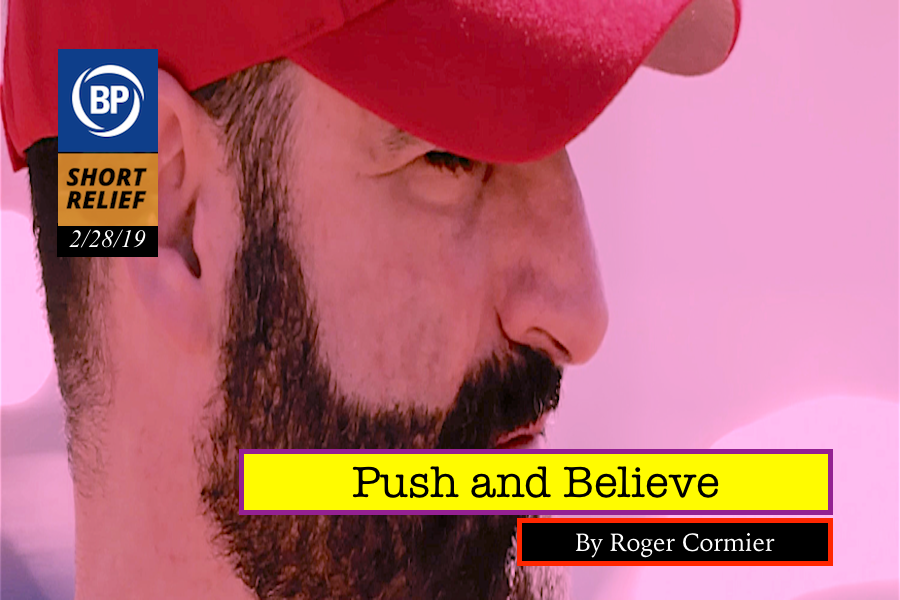
Comedian Brody Stevens died last week of an apparent suicide. He was 48.
Stevens was one of a kind. The phrase “comic’s comic” actually applies with him. Not even Dick Van Dyke himself could tell if Stevens was killing or bombing during sets.
It wasn’t just Van Dyke and other popular comedians who commented and expressed sorrow on his passing – it was baseball players and coaches like Jake Arrieta, and Dan Haren, and Justin Turner, and Kevin Youkilis, and Joe Maddon.
His cadence was as distinctive and earworm-y as Mitch Hedberg’s without ripping off Hedberg at all. Almost the exact opposite, really. Stevens was intense. He talked about it all the time, how he was burdened with the mentality of an athlete forced to live a quotidian life. Whole Foods couldn’t contain him; Trader Joe’s wanted his business. Describing his act is a futile effort – it just sounds like peak toxic masculinity: an ex-athlete rattling off his Hollywood resume (he was in The Hangover, cut out of the impossibly long Funny People), demanding the audience show him respect. It was a joke on ex-jocks pretending to still be the big man on campus. He got it. You got it.
Hidden away in the middle of the lone season of Brody Stevens: Enjoy It!, which Comedy Central aired early Monday mornings at midnight in the dead of winter five years ago, was a great segment where Stevens relived the peak of his baseball career. Stevens was a star pitcher at Reseda High School, outdueling future closer Rod Beck in a playoff game 1-0. Stevens is certain he’s not going to walk a batter. He’s certainly not going to give up a home run and lose the game. He’s definitely not going to pitch briefly for Arizona State University only to hurt his arm and find a new vocation entirely. We all know where this is going. That’s okay, because it is Stevens and Zach Galifianakis in catcher’s gear. It’s still funny.
My favorite story was sadly never filmed live, nor reenacted for posterity; we only have comedian Matt Braunger’s recollection. Braunger and Stevens performed in front of “every great living baseball player” at a huge private Florida resort for a benefit in 2010. While Braunger, one of the best comedians out there but not a baseball fan, did okay, Stevens completely destroyed. Walking through the audience “like a pissed off coach”, he called out the players individually, reciting their stats dating back to high school and bringing up mistakes they made. He poked Ken Griffey Jr. and screamed, “I touched him. I win!” The players laughed so hard they cried. Griffey went up to Stevens after the set. He poked him and said “I touched you.” “He was like a kid,” Braunger remembered of Griffey, probably not realizing the pun on his nickname. “We all were. Just grinning. Comedy is so fun.”
Griffey Jr. attempted suicide when he was 17 years old after his first year in the minor leagues. He first went public with the story in 1992, hoping it could show others would not follow his lead. “Don’t ever try to commit suicide,” Griffey said he wanted to tell kids. “I am living proof how stupid it is.”
Sadly, it is not that simple. Depression turns your brain into your worst enemy. It tells you there’s no way out. Logic is no longer considered. It’s hard for loved ones who don’t suffer to understand because they can’t see the depression on an X-ray or MRI, like you would an arm injury.
Stevens had been open about his depression and anxiety. In his last Periscope he told viewers he was back on Lexapro after time off of it, noting he was unhappy about feeling anxiety in his chest. He was scheduled to visit the Cubs this week in Arizona.
The National Suicide Prevention Hotline is 1-800-273-8255. Okay Together is a website full of stories from athletes and celebrities who suffer from depression and anxiety curated by Red Sox broadcaster Josh Lewin. As corny as it sounds, you are not alone.
Thank you for reading
This is a free article. If you enjoyed it, consider subscribing to Baseball Prospectus. Subscriptions support ongoing public baseball research and analysis in an increasingly proprietary environment.
Subscribe now